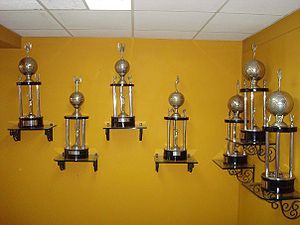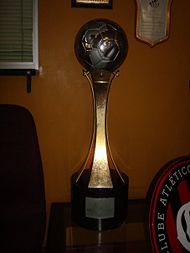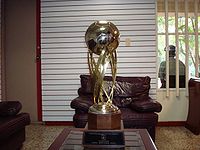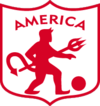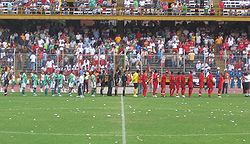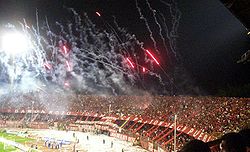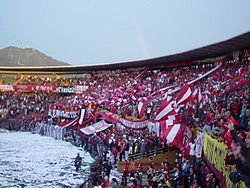- América de Cali
-
América (de Cali) 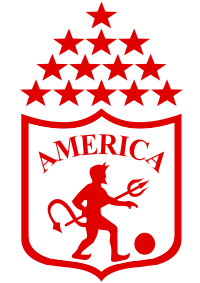
Full name Corporación Deportiva América Nickname(s) Los Diablos Rojos (The Red Devils)
Los Escarlatas (The Scarlets)
La Mechita (The Fuse)Founded 21 December 1918
(as América Football Club)
13 February 1927 (officially)Ground Estadio Pascual Guerrero
(Capacity: 45,625)Chairman Juan Ramon Lopez Tejera Manager Wilson Piedrahita League Categoría Primera A 2011 Apertura First Stage: 12th Home coloursAway coloursThird coloursCorporación Deportiva América, commonly known as América de Cali or simply América is a Colombian football club based in Cali. They currently play in the Categoría Primera A, the top-flight professional league in the country.
América de Cali has success at both the domestic and international level. With thirteen national championships, they are tied with Millonarios as the most successful team in Colombia. Internationally, they were the runner-up of the Copa Libertadores for three consecutive years from 1985–1987. They finally won an international trophy after winning the 1999 Copa Merconorte. Despite a lack of international silverware, IFFHS named América de Cali one of the top-ten clubs in South America in the 20th century.
The club was officially founded in 1927, but traces it origins to the América Football Club founded in 1918. América has rivalries with a number of teams in Colombia, most notabily with crosstown rivals Deportivo Cali. Matches between them are known as the "Clásico vallecaucano". Other rival clubs include Atlético Nacional and Millonarios. . The club plays their home matches at Estadio Pascual Guerrero.
Contents
History
The beginning
The team's roots trace all the way back to 1918, when some students from Colegio Santa Librada formed their own team, called "América F.C.", to compete with other schools. The team won the Copa Centenario Batalla de Boyacá in 1919. The team's uniform was light blue with white vertical stripes, light blue shorts, and socks with horizontal stripes in white and light blue.[1][2][3]
The curse of "Garabato"
Benjamin Urrea, better known as "Garabato", was a dentist and one of the most faithful fans of "la mechita".[4] He was very strongly opposed to the professionalization of the club, and when he learned of this process being carried out by Humberto Salcedo Fernández, he placed a curse on the institution. He is quoted as saying "que lo vuelvan profesional, que hagan con el equipo lo que quieran... que, por mi Dios, América nunca sera campeón", which means "if the team is professionalized, I swear to God that it will never be champion". Although it is said that this curse was broken in 1979 when the team obtained its first national title, there are many people who believe the curse still holds true in the Copa Libertadores since America has reached 4 finals and never been able to win the cup.[5] The popular "Garabato" died on 5 January 2008 in Cali.[6]
The first championships
América got off to a slow start in the Colombian tournament, not achieving even the runner-up position until 1960 and not playing its first Copa Libertadores until 1969. However, the team went through a radical change in 1979, hiring Gabriel Ochoa Uribe as its coach. During the 12 years Gabriel Ochoa Uribe worked as coach of the team, América obtained its first seven National Cups and rapidly created an immense diversity of fans that cheered it around the country. During these years, América finished second place in the Copa Libertadores consecutively from 1985–1987.
1979 "Aquel 19" The First Star
Every achievement América de Cali had made throughout its history would be surpassed on 19 December 1979, better known as "Aquel 19" like the popular song by Alberto Beltran. Among these achievements were the 5–0 victory over Deportivo Cali, the undefeated season of 1967, the Second Place finish in 1960 and 1969, and their impressive journey in the 1970 Copa Libertadores. On "Aquel 19" ("That 19"), the entire city of Cali celebrated the team's first national title. Gabriel Ochoa Uribe said, "We are going to be champions. We deserve it. This night we will write history." That night, América de Cali overcame a difficult adversary Unión Magdalena, in order to be recognized as the 1979 Colombian Soccer Champion. This unforgettable night, the entire city was painted red with the fans who celebrated until the next day.1982 A Title in the Cold
After just three years of winning their first title, "La Mecha" was heading towards their second one. It was a cold and grey morning that day in Bogotá, where the team faced Millonarios. With noise and an old bus, América de Cali arrived to the stadium Nemesio Camacho (El Campín). Caleños that lived in the city came to support the team as well as many fans arriving from Cali. Millonarios came out with their full attack, but América de Cali played with tranquility and soon enough the first goal came As they kept a close watch on the other games being played that day, América de Cali withstood the constant attack of Millonarios. Time took an important role and as it ran down, it only benefited América de Cali. Deportes Tolima had won their match, Pereira were tying their match, and Nacional had scored their second goal. Everything was going their way and the only thing left to do was win the game against Millonarios. The final minutes were very tense, but once the referee blew the whistle, the fans were able to chant once more, "América Campeon".1983 Third Star
América de Cali began the season with some changes to create a stronger team for the Copa Libertadores. It included the arrivals of Daniel Teglia, Claudio Casares, Willington Ortiz, Rafael "Vallenato" Agudelo, Henry Alape, Jorge Porras, and Luis Antonio Marcollata. They also brought reinforcement with Brazilians Ademir Praticio and Coccota. With a good participation in the Copa Libertadores "Los Diablos Rojos" were eliminated in the semifinal round. Gabriel Ochoa Uribe used his experience to prevent the players from losing their head, in order to accomplish one of the two titles. Willington Ortiz and Juan Manuel Battaglia shone for the team and the dynamic duo combined, scored 40 goals that season. Once the second round began only one team was considered favorite, América de Cali. With the spirit and hard work, América de Cali were back to back champions.1984 "Champions for a While"
With the same tactics and strength, América de Cali went for their fourth star. With minor changes in the team, it looked to head for their third consecutive title. Under the management of Gabriel Ochoa Uribe, it seemed that the next star would once again be red. Ochoa, showing the country that he was one of the best coaches at the time, proved it by leading the team to various accomplishments. With the fourth star in his pocket, Ochoa showed that América de Cali was here to stay for good.1985 Fifth Star; Champions once Again
With a great team and head coach, the "Red Devil" fans felt the star at hand. Everyone remembering their first star just 6 years before. These last few years had been great for the team and its history. With a quick season, América de Cali was awaiting once again the last match to become champions once again. They faced an Junior team, who did not want to get humiliated in their last game. América de Cali came out with everything, putting in two creative midfielders, and . With a quick goal it seemed to be an easy game for the Devils, but Junior pulled together and played it safe, to at least leave with a decent result. América de Cali continued to attack, but the opponent's defense stood well and did not let anything else happen. With a few plays dangerous plays from both sides, in the end, America won with a minimum difference 1–0, obtaining the fifth star for the "Red Devils".1986 Five consecutive titles
The "Red Devils" made history this year by obtaining five national titles in a row; the highest number of consecutive titles previously was four, by Millonarios. The star was won against their rivals Deportivo Cali, which made the achievement even more special for both the fans and the players.1990s
The 1989 tournament was suspended due to the assassination of the referee, Álvaro Ortega. The following year in 1990, América de Cali was once again champion and the following year marked the departure of Gabriel Ochoa Uribe. With his departure, many feared that the winning streak for the "Red Devils" was over. Despite this belief, in 1992, with Francisco Maturana as head coach and Diego Edison Umaña as assistant, América obtained its eighth star and appeared to continue its winning streak from the prior decade. Five years later, América de Cali was able to taste another championship; this was the longest tournament in the history of Colombian Professional Soccer, lasting a year and a half. During this year, America held the first position during the entire tournament and they were crowned champions of the 1996–1997 season after the final match against Atlético Bucaramanga.
Also in 1996, América was recognized by the IFFHS official world club ranking as the second best team in the world,[7] preceded by Juventus of Italy. The team has been ranked 35th in the All-Time Club World Ranking of the IFFHS (International Federation of Football History & Statistics)[8] In 1999, America disputed the national title with Atlético Nacional, in the end losing by way of penalty kicks. After playing two finals in less than three days, America finished the year off with excellent achievements: runner-up of Copa Mustang and winner of the 1999 edition of Copa Merconorte, the team's first international title, against Santa Fe.
The fourth Libertadores final "Garabato strikes again"
- 1996 América de Cali once again reached the final of the Copa Libertadores, again with River Plate. America won the first game in Cali 1–0 with an excellent goal by Antony de Ávila from a very closed angle. This was América's chance for revenge after the loss in the 1986 final against the same rival, but in the end América lost famously on an Óscar Córdoba error. The first goal was scored by Hernan Crespo and in an incredible play by Óscar Córdoba, where he left the box and did not clear the ball correctly, Hernan Crespo scored the second goal.
The new millennium and the "Clinton List"
Despite having won the Colombian League three more times from 2000–2002, América has entered the millennium in economic hardship, and unable to match the successful team of the 1980s. In 1995, Corporación Deportiva América was placed under watch by Executive Order 12978, commonly known in Colombia as the Clinton List. Because of its past connections with drug cartels, the United States froze the team's assets in the U.S. (valued around $1 million), and ordered other companies not to conduct direct business with América. Also, according to the club's president, Carlos Puente, the club never received the prize money of $200,000 from the Copa Merconorte championship. Since then, América's economic crisis has been severe. Currently immersed in nearly $2 million dollars worth of debt, América has survived four years without a direct sponsor and only receiving money through minimum attendance at the Pascual Guerrero and the selling of soccer jerseys. The monthly salaries of its players do not exceed $3000 dollars, and América has seen itself forced to make money by selling its most recognized players.
However, despite its troubling economic situation, América has maintained a respectable level of play. In 2003, America again faced River Plate in the quarterfinal round of the Copa Libertadores, and got their revenge by winning 4–1 (see video).
After three tournaments without reaching the final round, in 2007 América was finally able to do so with Diego Edinson Umaña as head coach and the assistance of Alex Escobar. The team had an excellent season and was a firm candidate to win the tournament, in the end falling short by only one goal. Despite this, the team was not left empty-handed, since they obtained a berth to the Copa Sudamericana 2008, after 3 years of not participating in an international event. For the 2008 season, Diego Umaña extended his contract and is currently in the process of preparing the team for both the Copa Mustang and the Copa Sudamericana.
In 2008 América de Cali began efforts to get off the hated Clinton List. The club and the Mayor of Cali held discussions to change the team name and management, but keep all the trophies they have obtained. In the 2008-II Season, America defeated Independiente Medellín 4–1 on aggregate to win its thirteenth title and qualify for the 2009 Copa Libertadores. However, during the last 2 years they have been unable to return to the playoffs mainly due to financial problems.
Uniform
Home
As for the red color, is important to note, that according to historical versions recovered, America first started out using the colors blue and white, which belonged to Racing Club from Avellaneda; then América switched to red and blue. From 1927 to 1931, it alternated between a red shirt and white shorts to a white shirt and red shorts. The first goal keeper of America and one of the founders of the club, said in a chance that the first red uniforms were purchased in the only sports store, Mr. Anzola property, that had in the city, at street 13 between 8th and 9th avenues.[9] In 1931, after a basketball game in Barranquilla, witnessed by the secretary of the delegation, Hernando Lenis, between the Union of Colombia and the "Red Devils" uniform of that color, América adopted the new color, that matched with the name that had been granted. Since then, América kept the red.
1918–1925 1926 1927–1931 1931–1984 Adidas 1985 Adidas 1986–1987 Umbro 1993 Adidas 1994 Nanque 1995–1996 Topper 1997–1998 Kappa 2000 Kappa 2001 Kappa 2002 Kappa 2003 Keuka 2004–2007 ASW 2008 NAS 2009 I NAS 2009 II NAS 2009 III Saeta 2010 Puma 2011 Away
Throughout history, América de Cali has had several uniforms alternative, mostly white with red; although it has come to use other colors like black or blue. The first alternative uniform that is remembered is red shorts and white shirt.[9] In some tournaments in the 40's and 50's it used some commemorative models, including an alternative similar to the uniform of Valle selection (white shirt with a red stripe that go down left to right and red shorts).[10] In 1958 the team used a similar uniform to Racing Club de Avellaneda, in honor of the first uniform of América.[11]
1927–1931 1931–1948 1949 50's 1958 1959–1984 Adidas 1985 Adidas 1986–1987 Umbro 1993 Adidas 1994 Nanque 1995–1996 Topper 1997–1998 Kappa 2000 Kappa 2001 Kappa 2002 Kappa 2003 Keuka 2004–2007 ASW 2008 NAS 2009 I NAS 2009 II NAS 2009 III Saeta 2010 Puma 2011 Third
In mid 2006 América used a black color uniform with the emblems of some sponsors recognized as Playboy, although it was used only in some games tournament, now this uniform is the second alternative.[12]
Keuka 2006 Keuka 2007 ASW 2008 NAS 2009 Saeta 2010 Puma 2011 Crest
The devil first appeared on the crest in 1940 because of the popular belief that the players "played like devils" on the field. During Gabriel Ochoa Uribe's twelve years with the institution, the devil was always an inconvenience for him so it was removed due to religious reasons. For this reason, the crest only carried the number of stars or titles obtained by the club.
In 1992, the devil was completely removed and was only used for the administrative aspects of the institution. As a celebration of the club's 70 years, the devil was put back on the uniforms. From this date forward, any malignant beliefs regarding the devil have been completely removed. In 2007, in order to conmemorate the club's 80 years of existence, the devil was temporarily replaced with a logo that reads "80 años" (80 years) and underneath "1927–2007"; above the crest are the 13 stars obtained by the club. In 2010 the devil returns to the crest, in the Saeta shirts, which is the new sponsor.
Stadium
Rivalries
América de Cali vs Deportivo Cali
This game is called "el clasico vallecaucano", which translated into English means "the Cauca valley derby." There is a long standing rivalry between these two teams and they have 21 titles combined (one more than Millonarios vs Santa Fe combined), making Cali one of the most important cities in this sport. The first trace of this derby match was in the final of a local tournament in 1931, where América was defeated by The Cali Football Club 0–1; the referee did not count two of América's goals because of supposed offsides plays. Due to the referee's poor performance, América published a series of articles as a protest, leading to the team's suspension from local tournaments for a period of one year.[13] Cali and America have played 266 "clasicos": with 101 wins for Cali, 86 wins for América and 81 draws. In 1969, Deportivo Cali defeated America and won the championship. In 1986, América obtained its fifth consecutive title in the final match against Deportivo Cali and also another title in 1992. This match currently brings 30 to 35 thousand spectators to the stadium.
América de Cali vs Atlético Nacional
This is one of the most followed games in Fútbol Profesional Colombiano. Since 1979, América and Nacional have seen each other in 15 finals (previously, finals were between more than 2 teams). The most recent final between the two was in 2002, where América was able to defeat Nacional in both matches and as a result obtained the 12th title in its history. Statistics from matches between these two teams show that this is the most even "clasico", with 79 wins for América, 74 for Nacional, and 75 draws. The first time they faced each other in Copa Libertadores was in 1991, and up to this date América has 6 victories, Nacional has 4, and there was one draw.[citation needed]
América de Cali vs Millonarios: The "clásico" with the most stars
These two teams combined have 26 titles and also count with numerous supporter groups known as barras bravas. The rivalry began in the late 70s when América obtained its first title and it grew throughout the 80s, a decade dominated by these two teams. Out of the 10 titles from this decade América won 5 of them and Millonarios won 2. In the 1982 final, América de Cali defeated Millonarios in El Campín, reaching the second title in the club's history. This game was known to paralize the entire country and they fought the 1989 title shoulder to shoulder, until it was cancelled.
América de Cali vs Santa Fe: the dispute over the color red
This is a much more recent rivalry which does not have an exact date of origin, and it is mostly expressed by Santa Fe's followers. This reaction against the team was originated in the late 1980s and early 1990s when many of Santa Fe's best players were transferred to América de Cali with little economic compensation, and in the end favored América with obtaining various titles. In the 1999 edition of Copa Merconorte, these two teams faced each other in the final; América lost 2–1 in Cali and then went to Bogotá and won 1–0. The game was decided by penalty shootouts, where América obtained its first international title. On 11 May 2005, in a game played at El Campín, a fight broke out between the teams' barras bravas leaving one person dead. The game' score was América 5 – Santa Fe 2 when the game was suspended, América was later declared the winner. This unfortunate event made the rivalry grow even more, although this only occurs in the city of Bogotá; in Cali it is just another game.
Current squad
- As of 20 February 2011.
Note: Flags indicate national team as has been defined under FIFA eligibility rules. Players may hold more than one non-FIFA nationality.
No. Position Player 1 
GK Diego Restrepo 2 
DF Andrés Cadavid 3 
DF Pablo Melo 4 
DF Jhon Lozano 5 
DF Mario Llanos 6 
DF Julio Ortíz 7 
MF David Holguín 9 
MF Jefferson "El Chotico" Rangel 10 
MF Jorge Artigas 11 
FW Mario Sergio Angulo 12 
GK Kevin Piedrahita 14 
MF John Jairo Pai 15 
MF Jorge Banguero (captain) 16 
DF Jersson González 17 
MF Paulo César Arango No. Position Player 18 
FW Jairo Castillo 19 
MF Alex Del Castillo 20 
MF Fernando Cardenas 21 
DF Rubén Darío Bustos 22 
DF Fabián Morales 23 
DF Andres Felipe Gallego 24 
FW Edward Benavides 25 
MF Diego Vergara 26 
FW James Cabezas 28 
DF Julio Murillo 29 
DF Julio César Ortiz 33 
GK Julian Viáfara 88 
MF Jaime Cordoba 
MF Jhon Cardona 
FW Jhonny Balanta Coaching staff
Role Name Head Coach  Wilson Piedrahita
Wilson PiedrahitaAssistant Coach  Carlos Fernando Asprilla
Carlos Fernando AsprillaTrainer  Mauricio Ortiz García
Mauricio Ortiz GarcíaMedic  Carlos Muñoz Galarza
Carlos Muñoz GalarzaHonors
- Regional
- Copa Centenario Batalla de Boyacá (1): 1919
- Campeonato Departamental Amateur (4): 1923, 1927, 1930, 1932.
- National
- Primera A (13): 1979, 1982, 1983, 1984, 1985, 1986, 1990, 1992, 1997, 2000, 2001, Apertura 2002, Finalizacion 2008.
- International
- Copa Merconorte (1): 1999
- Friendly
- Copa Cafam: 2008, 2011
- Copa Sky: 2001
- Copa Ciudad Viña del Mar: 2000
- Copa Osvaldo Zubeldía: 1982
- Copa Ciudad de Cali: 1979
- Copa Simón Bolívar: 1976
Presidents
- Humberto Salcedo Fernández (1948)
- Manuel Correa Valencia (1949)
- Luís Carlos Cárdenas (1950)
- Manuel Correa Valencia (1951–55)
- Pedro Sellares (1956–64)
- Gustavo Valdés (1961)
- Jorge Rengifo (1965)
- Gonzalo Zambrano (1966)
- Alberto Anzola (1966–73)
- Juan De Dios Guerrero (1974–75)
- Ricardo León Ocampo (1976–78)
- José Sanguiovanni (1979–86)
- Juan José Bellini (1987–91)
- Pedro Chang (1993–94)
- Álvaro Muñoz Castro (1994–96)
- Carlos Puente (1996-09)
- Álvaro Guerrero Yanci (2009)
- Juan Ramón Lopez Tejera (2011)
Records
Most goals scored
Rank Name Goals 1  Antony de Ávila
Antony de Ávila203 2  Jorge Ramón Cáceres
Jorge Ramón Cáceres135 3  Juan Manuel Battaglia
Juan Manuel Battaglia93 4  Armando Torres
Armando Torres90 5  Orlando Maturana
Orlando Maturana74 6  Jairo Castillo
Jairo Castillo73  Alex Escobar
Alex Escobar73 8  Camilo Cervino
Camilo Cervino65  Jorge da Silva
Jorge da Silva65 10  Leonardo Fabio Moreno
Leonardo Fabio Moreno64 Most appearances
Rank Name Apps 1  Alex Escobar
Alex Escobar505 2  Antony de Ávila
Antony de Ávila488 3  Luis Eduardo Reyes
Luis Eduardo Reyes396 4  Gilberto Cuero
Gilberto Cuero389 5  Julio César Falcioni
Julio César Falcioni376 6  Hugo Valencia
Hugo Valencia357 7  Juan Manuel Battaglia
Juan Manuel Battaglia353 8  Gabriel Chaparro
Gabriel Chaparro340 9  Víctor Lugo
Víctor Lugo325 10  Gerardo González Aquino
Gerardo González Aquino312  Foad Maziri
Foad Maziri312 Notable players
 Hugo Tocalli (1976–77)
Hugo Tocalli (1976–77) Juan Manuel Battaglia (1979–89)
Juan Manuel Battaglia (1979–89) Gerardo Gonzalez Aquino (1979–85)
Gerardo Gonzalez Aquino (1979–85) Aurelio Pascuttini (1979–82)
Aurelio Pascuttini (1979–82) Ladislao Mazurkiewicz (1980)
Ladislao Mazurkiewicz (1980) Julio César Falcioni (1981–89)
Julio César Falcioni (1981–89) César Cueto (1982–83)
César Cueto (1982–83) Willington Ortiz (1982–88)
Willington Ortiz (1982–88) Roque Raul Alfaro (1983)
Roque Raul Alfaro (1983) Roberto Cabañas (1984–89)
Roberto Cabañas (1984–89) Guillermo La Rosa (1984–85)
Guillermo La Rosa (1984–85) Ricardo Gareca (1985–88)
Ricardo Gareca (1985–88) Antony de Ávila (1985–97), (2009)
Antony de Ávila (1985–97), (2009) Carlos Ischia (1986)
Carlos Ischia (1986) Sergio Santin (1987–89)
Sergio Santin (1987–89) Julio César Uribe (1989)
Julio César Uribe (1989) Jorge Raul Balbis (1989–92)
Jorge Raul Balbis (1989–92) Jorge da Silva (1991–93)
Jorge da Silva (1991–93) Wilmer Cabrera (1990–97)
Wilmer Cabrera (1990–97) Eduardo Niño (1990–98)
Eduardo Niño (1990–98) Albeiro Usuriaga (1990–93)
Albeiro Usuriaga (1990–93) Jorge Bermúdez (1991–96)
Jorge Bermúdez (1991–96)
 Nestor Fabbri (1992)
Nestor Fabbri (1992) Ángel David Comizzo (1993)
Ángel David Comizzo (1993) Óscar Córdoba (1993–97)
Óscar Córdoba (1993–97) Jersson González (1993-02, 2004–06, 2008–09)
Jersson González (1993-02, 2004–06, 2008–09) Giovanny Hernández (1994–96)
Giovanny Hernández (1994–96) Marco Etcheverry (1995)
Marco Etcheverry (1995) Eber Moas (1995–96)
Eber Moas (1995–96) Adolfo Valencia (1997)
Adolfo Valencia (1997) Javier Ferreira (1997–98)
Javier Ferreira (1997–98) Fabián Vargas (1998-02)
Fabián Vargas (1998-02) David Ferreira (2000–05)
David Ferreira (2000–05) Luis Barbat (2000–02)
Luis Barbat (2000–02) Manuel Neira (2001–02)
Manuel Neira (2001–02) Pablo Armero (2004–08)
Pablo Armero (2004–08) Fabián Estay (2005)
Fabián Estay (2005) Leonel Gancedo (2006)
Leonel Gancedo (2006) Pablo Galdames (2006)
Pablo Galdames (2006) Gustavo Adrián Ramos (2006–09)
Gustavo Adrián Ramos (2006–09)
Coaching history
link List of América de Cali managers
Name Nationality Years Fernando Paternoster 
1948 Donaldo Ross 
1948 Moises Emilio Reuben 
1949 Julio Tocker 
1950 Adelfo Magallanes 
1951 Julio Tocker 
1952–53 Ricardo Ruiz 
1954 Edgar Mallarino 
1955–59 Alejandro Genes 
1959 Adolfo Pedernera 
1960–61 Manuel Sanguinetti 
1961 Porfírio Rolón 
1961–62 Miguel Ortega 
1962–63 Francisco Pacheco 
1963 Porfírio Rolón 
1963–64 Francisco Solano Patiño 
1964–65 Porfirio Rolon 
1965 Juan Eulogio Urriolaveitia 
1965 José María Minella 
1966 Carlos Tulio Obonaga 
1966 Porfírio Rolón 
1966–67 Julio Tocker 
1967 Porfírio Rolón 
1968 Angel Perucca 
1968–70 Guillermo Reynoso 
1970–71 Edgar Barona 
1972 Jorge Ruiz 
1972–73 Simo Vilić 
1973–75 Name Nationality Years Pedro Nel Ospina 
1975 Julio Tocker 
1976 Adolfo Padernera 
1977 Pedro Nel Ospina 
1977 Victor Pignarelli 
1978 Gabriel Ochoa Uribe 
1979–91 Diego Edison Umaña 
1992 Francisco Maturana 
1992–93 Diego Edison Umaña 
1993 Hugo Gallego 
1994 Pedro Sarmiento 
1994 Diego Edison Umaña 
1994–96 Luis Augusto García 
1996–97 Diego Edison Umaña 
1998 Jaime de la Pava 
1999-02 Fernando Castro 
2002–03 Alberto Suarez 
2004 Ricardo Gareca 
2005 Otoniel Quintana 
2005 Luis Augusto García 
2005 Hernan Dario Herrera 
2006 Bernardo Redin 
2006 Gerardo González Aquino 
2006–07 Roberto Cabañas 
2007 Diego Edison Umaña 
2007–09 Juan Carlos Gruesso 
2010 Jorge Bermudez 
2010 Álvaro Aponte 
2011 References
- ^ Colombia – Foundation Dates of Clubs
- ^ [1][dead link]
- ^ Un Portal a la Historia del Deporte Arcotriunfal.com
- ^ [2][dead link]
- ^ [3][dead link]
- ^ Cali Colombia deportes Adiós a Adiós a "Garabato" El Pais
- ^ International Federation of football History and Statistics IFFHS
- ^ All-Time Club world Ranking of the IFFHS
- ^ a b Copa Mustang (18 May 2007). "America de Cali's founders". http://www.copamustang.com/scripts/historia.php?sec=841. Retrieved 9 March 2008.
- ^ Copa Mustang (18 May 2007). "See photo 1953". http://www.copamustang.com/scripts/historia.php?sec=850. Retrieved 3 July 2008.
- ^ Copa Mustang (18 May 2007). "See photo 1958". http://www.copamustang.com/scripts/historia.php?sec=856. Retrieved 3 July 2008.
- ^ Bestiario del balón (18 May 2007). "América Play Boy". http://bestiariodelbalon.com/2007/01/15/412/. Retrieved 9 March 2008.
- ^ Nuevo Estadio :.: La Publicación Deportiva que más vende en Colombia[dead link]
External links
- Corporación Deportiva América de Cali
- Official DIMAYOR Page
- Official Myspace Fan Page
- Official Baron Rojo Sur Fan Page
Current (2011) teams América · Atlético Huila · Atlético Nacional · Boyacá Chicó · Cúcuta Deportivo · Deportes Tolima · Deportes Quindío · Deportivo Cali · Deportivo Pereira · Envigado · Independiente Medellín · Itagüí Ditaires · Junior · La Equidad · Millonarios · Once Caldas · Real Cartagena · Santa FeSeasons 1948 · 1949 · 1950 · 1951 · 1952 · 1953 · 1954 · 1955 · 1956 · 1957 · 1958 · 1959 · 1960 · 1961 · 1962 · 1963 · 1964 · 1965 · 1966 · 1967 · 1968 · 1969 · 1970 · 1971 · 1972 · 1973 · 1974 · 1975 · 1976 · 1977 · 1978 · 1979 · 1980 · 1981 · 1982 · 1983 · 1984 · 1985 · 1986 · 1987 · 1988 · 1989 · 1990 · 1991 · 1992 · 1993 · 1994 · 1995 · 1995–96 · 1996–97 · 1998 · 1999 · 2000 · 2001 · 2002 · 2003 · 2004 · 2005 · 2006 · 2007 · 2008 · 2009 · 2010 · 2011Early competitions Categories:- América de Cali
- Association football clubs established in 1927
- Colombian football clubs
Wikimedia Foundation. 2010.

